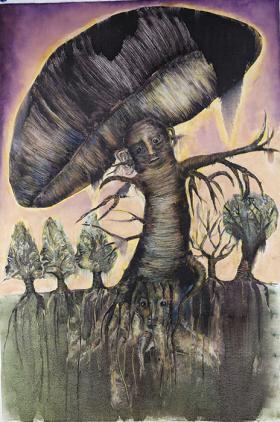Christine Sefolosha, Waldszenen
Fables, fairy tales, apparitions… Christine Sefolosha summons the presence of spirits for her fifth personal exhibition at Polad-Hardouin gallery. Unafraid of the outcome, she lets herself be carried by visions that happen “in spite of herself”. Taking pleasure in her own lack of control over the creative process as a whole, she deliberately introduces an element of uncertainty. The monotype technique that she has been using for several years opens the door to the unpredictable during the printing process.
As for her folded or “Rohrschach” papers –dipped in different inks, then unfolded –, they give rise to shapes from which the artist will allow her visions to emerge: zoomorphic creatures, deer antlers, masks, totems, ghosts, and many other entities invite the viewers to follow them through the Looking-Glass, and to give a perceptible form to the invisible forces that surround them.
With their knowingly broken symmetries, these folds naturally introduce the themes of the double and twinning. In Le voyage (“The journey”), two young girls with ashen faces set upon a bizarre crossing. Between the two, a small divinity with an enigmatic smile seems to arbitrate the direction they are to take. A multitude of eyes suggest the presence of beings that animate the landscape. Cadet Rousselle also plays with the echo of shapes that answer one another: each of the characters’ items of clothing carries a story in its patterns, while the flowers shine like nocturnal suns over the ghostly landscape.
Memories also take shape in ink blots, and answer one another. For her fables are also charged with an autobiographical dimension, interspersed with elements that originate from the artist’s life. On the banners flying overthe landscape of Cadet Rousselle, one can read the words “Cry the Beloved Country”, an explicit reference to the novel by South-African author Alan Paton. Christine Sefolosha’s passage through Africa was seminal to her artistic practice, and a defining moment of her existence.
But if her African experience consolidated her proximity to the supernatural world, there is no need to go that far to encounter the world of spirits. For this exhibition, Christine Sefolosha draws from the sources of Europe’s primitive world, from her childhood’s totemic figures, typical of Vaud and Appenzell, such as deer whose antlers are like inverted roots pointing toward the sky, or the Tschäggatä witches (1) of the winter processions. “With the help of my pictures, through the prism of my own experience and intuitions, I probe into everyone’s roots, the roots that connect us to the collective subconscious of which I consider myself to be the recipient”, she writes.
In today’s increasingly rapidly changing world, Christine Sefolosha’s paintings invite us – not unlike Robert Schuman’s Waldszenen (2) – to suspend for a moment all this agitation and take the path that goes through the woods, in order to rediscover the ancestral spirits that still dwell in their depths.
Born in 1955 in Switzerland, Christine Sefolosha lived in South Africa for nine years. This experience left a deep mark in her artistic practice. Since then, this self-taught artist has taken part in numerous exhibitions in Swiss, French, and American museums (Lagerhaus Museum in Sankt Gallen, Halle Saint-Pierre in Paris, the American Visionary Art Museum in Baltimore…). Her works are regularly exhibited in New York, Chicago, Paris, and Switzerland. Since 2003, she is regularly featured at Polad-Hardouin gallery.
(1) The name given to the witches who appear at the door of Swiss farmers.
(2) "Waldszenen": from Robert Schumann’spiece. The title can be translated literally as “scenes from the woods”.
